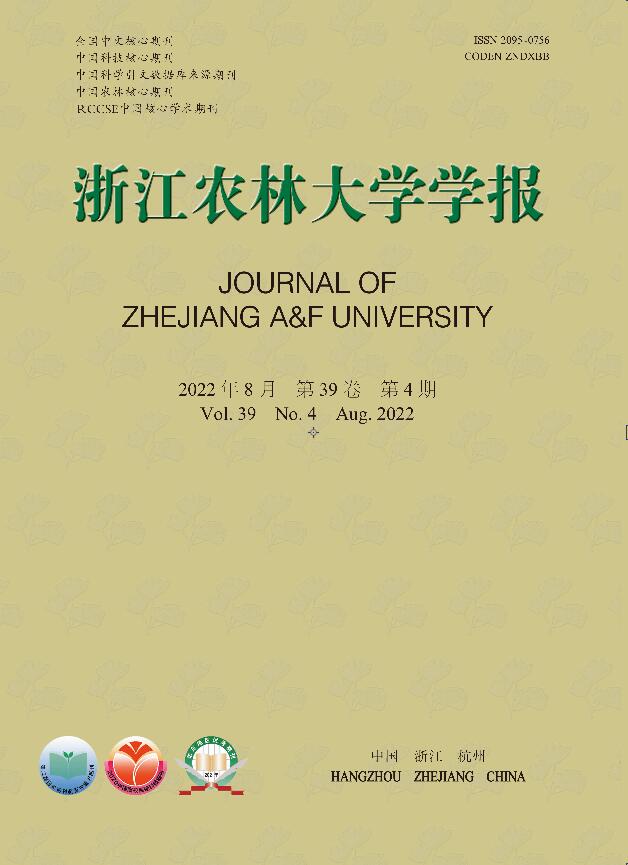-
不定根是指从植物茎或叶等非中柱鞘组织产生的根。不定根发生既是植物器官分化的重要理论问题,又关系到无性繁殖和完整植株的再生。多数木本植物不定根发生难度较大,从而阻碍了无性繁殖技术的应用,尤其是制约了诸多果树、林木和木本花卉的工厂化育苗。因此,探究木本植物不定根发生机理是突破无性繁殖技术瓶颈的迫切需求。木本植物不定根发生机理的研究始于对不定根发生过程的解剖观察,通过显微观察解析了不定根发生的类型和过程,可为深入的机制研究奠定形态学基础[1]。随着生根过程中激素、酶等物质的变化规律及调控机制的深入研究,生理生化水平上的不定根发生相关理论日益完善[2-4]。近年来,植物分子生物学技术的高速发展有力地推动了木本植物不定根发生的分子机制研究,目前已克隆出多个参与生长素合成代谢的相关基因[5],并鉴定出诸多参与不定根形成的转录因子[6]以及微小核糖核酸[microRNA(miRNA)][7]等,极大地丰富了木本植物不定根发生机制的内容。本研究从解剖学、生理学以及分子生物学这3个层面,系统综述了木本植物不定根发生机制研究进展,以期为解析木本植物不定根发生机制提供理论依据。
-
依据根原基形成时间不同,可将不定根分为潜伏根原基型和诱生根原基型[8]。潜伏根原基型的根原基在外植体离体前便已产生并一直处于休眠状态,离体后在适宜条件下打破休眠,发育形成不定根,通常这种类型的植物不定根发生难度小,例如南林895杨Populus × euramericana ‘Nanlin 895’[9]、冬青Ilex chinensis[10]等。诱生根原基型的根原基形成需要适宜的环境条件诱导,发生有2种途径:①诱导组织内薄壁细胞恢复分生能力进而分化出根原基,然后形成不定根;②在外植体基部先分化出一部分具有旺盛分裂能力的愈伤组织,再由愈伤组织分化出根原基,进而形成不定根。目前,生根难度较大的木本植物通常属于诱生根原基型,例如银杏Ginkgo biloba[11]、牡丹‘太平红’ Paeonia suffruticosa ‘Taipinghong’[12]等。
-
不同木本植物的不定根发生部位存在差异,可发生根原基的部位包括皮层、韧皮部、形成层、髓射线、木质部和愈伤组织。依据根原基形成部位不同,可将木本植物不定根分为3种类型:①皮部生根型。指在皮层、韧皮部、形成层、髓射线、木质部等组织内部产生根原基,例如银杏[11]、桤木Alnus cremastogyne[13]。②愈伤组织生根型。指在愈伤组织中产生根原基进而形成不定根,愈伤组织产生是生根的前提,例如矮紫衫Taxus cuspidata var. nana[14]、四合木Tetraena mongolica[15]。然而,属于该生根类型的木本植物通常生根率较低且生根质量不高,这主要是由于一方面愈伤组织的形成会消耗大量营养物质,且老化的愈伤组织诱导生根难度较大;另一方面存在根与茎的维管组织连接不通畅的现象,继而导致根无法吸收水分和养分,此类为无效根。③混合生根型。在皮层、形成层等组织以及基部愈伤组织内均可产生根原基,例如牡丹‘正午’Paeonia × lemoinei ‘High Noon’[16]、桃Amygdalus persica[17]、侧柏Platycladus orientalis[18]等。
-
根据木本植物不定根发生过程中的组织形态变化,将生根过程分为3个时期[12, 19-20]:①脱分化期。该阶段薄壁细胞经过脱分化转变为代谢旺盛的胚性细胞,形成潜在的根原始点。②诱导期。该阶段主要特征是根原基的诱导形成。脱分化细胞经过刺激开始细胞分裂,形成分生组织细胞群,后进一步形成可见根原基。③分化期。该阶段根原基不断生长,细胞分化出现分层现象。根原基顶端产生多层根冠细胞并继续分裂分化成根尖,后方分生组织细胞逐渐延长形成维管组织,并与原组织中的维管束连接起来,最终根原基伸出表皮层,形成不定根。此外,不同木本植物的生根节点持续时间存在差异,例如牡丹‘太平红’[12]生根诱导3 d后维管束中出现根原基,12 d后根原基分化伸长并逐渐突破表皮,而海棠果Calophyllum inophyllum[19]扦插10 d后维管射线薄壁细胞才恢复分生能力,15 d达到根原基发育的高峰期。因此,通过解剖观察对生根阶段进行划分,是木本植物不定根发生机制研究的前提和基础。
-
多数木本植物不定根发生依赖外源生长素类物质诱导,常用外源生长素种类包括吲哚乙酸(IAA)、吲哚丁酸(IBA)、萘乙酸(NAA),其主要通过调控内源IAA含量来影响不定根发生。研究表明:内源IAA是促进不定根发生的主要激素,它对根原基诱导、愈伤组织形成以及根伸长均起着重要作用[21]。欧阳芳群等[22]和王青等[23]采用酶联免疫吸附法,对欧洲云杉Picea abies与麻楝Chukrasia tabularis不定根发生过程中的内源IAA含量进行测定,发现IAA含量在根原基诱导期迅速上升,并且峰值与根原基出现的高峰期基本一致,至不定根伸出表皮后其含量降低。尚文倩等[24]和de ALMEIDA等[25]进一步通过免疫组织定位法对牡丹‘凤丹白’Paeonia ostii ‘Fengdanbai’与桉Eucalyptus robusta不定根发生过程中的内源IAA进行定位,发现生根诱导开始时IAA主要分布在维管组织中,随着根原基的出现和发育,维管组织中的IAA信号逐渐减弱,根原基成为IAA分布中心。这些结果证实了IAA在根原基发端位置的积累是不定根发生的重要基础。此外,IAA不仅自身对生根起到促进作用,还能通过与其他内源激素间的互作,来调控不定根发生,例如内源IAA的运输受到脱落酸抑制,内源IAA含量过高能够诱导乙烯的产生,从而对生根产生抑制作用[26]。
-
植物体内天然存在的细胞分裂素类(CTKs)主要有玉米素核苷(ZR)、玉米素(ZT)、异戊烯腺苷(iPA)等,其中ZR在木本植物不定根发生中的作用得到广泛研究。已有研究证实:在牡丹‘太平红’[12]、杜鹃‘紫蝴蝶’Rhododendron pulchurum ‘Zihudie’[27]等植物的生根过程中,不定根脱分化期由于插穗处于离体初期,ZR的供应路线被切断,而其仍被正常消耗,因此ZR含量降低,一段时间后插穗自身开始合成ZR,其含量开始逐渐增加,在诱导期和分化期呈上升趋势,有利于增加细胞数量、提高细胞分裂速度,继而促进根原基的形成和生长。此外,内源细胞分裂素(CTK)和IAA的相对含量与根和芽的形成有关,CTK作为IAA的抑制剂,两者在生根过程中发挥着拮抗作用[28]。内源IAA/CTK值高,有利于不定根发生,而值低则利于诱导芽分化,但不利于根的诱导,例如白皮松Pinus bungeana[29]插穗和苹果Malus pumila[30]组培苗的生根率与IAA/CTK均呈正相关。
-
目前,关于赤霉素类(GAs)对木本植物不定根发生的作用仍存在较大争议。部分学者认为内源赤霉素(GA)对不定根发生起促进作用,例如GA4含量增加有利于落叶松Larix gmelinii插穗愈伤组织形成,继而促进愈伤组织中产生不定根[31]。然而,更多研究发现:内源GA抑制不定根发生,例如内源GA3含量与山杏Armeniaca sibirica[32]插穗的生根率呈负相关。BRIAN等[33]认为:内源GA对不定根发生主要有抑制作用,一方面GA抑制不定根原基细胞分裂,另一方面阻碍IAA对不定根的诱导。因此,内源GA和IAA的相对含量对不定根发生具有重要调控作用,IAA/GA值高,利于不定根发生[3]。综上,有关内源GA的种类和含量对不定根发生的作用及机制,仍有待进一步研究。
-
内源脱落酸(ABA)对不定根发生具有抑制作用,例如内源ABA含量高的毛白杨Populus tomentosa硬枝插穗生根能力低[34]。在麻楝[23]、山杏[32]等不定根发生过程中内源ABA含量呈动态变化,表现为脱分化期插穗受脱离母体刺激,ABA含量短暂上升,以提高插穗抗逆性,降低逆境对插穗的损伤,但是ABA含量过高会抑制根原基发育和不定根的伸长,因此当植株适应逆境后,ABA含量在脱分化后期下降并在诱导期持续下降,分化期含量低且稳定。然而,也有研究者认为:不能单纯将ABA视为抑制生根的激素,并提出将内源IAA/ABA值作为植物生根能力的衡量标准,且与生根能力呈正相关,例如毛白杨[35]、马尾松Pinus massoniana [36]、杂种鹅掌楸Liriodendron chinense × L. tulipifera[37]等生根能力强的插穗或组培苗中内源IAA/ABA值较高。此外,王清民等[38]和董胜君等[32]分别在核桃Juglans regia和山杏的生根研究中发现:IAA/ABA值呈先升后降的趋势,在根诱导期达到峰值,并推测高IAA/ABA值有利于根原基的形成。
-
除了上述内源激素外,乙烯(ET)、油菜素内酯(BRs)、茉莉素(JAs)、水杨酸(SA)等同样参与木本植物不定根发生。乙烯(ET)是不定根发生的刺激因子,乙烯合成受到内源IAA调控,同时也可以调节IAA的运输和信号传导[39]。ET对生根的影响主要体现在与IAA的相互作用中,两者对不定根发生具有拮抗作用,但对根毛的起始和伸长具有协同作用[40]。BRs是一种促进细胞伸长和分裂的甾体激素,较低的内源BRs能够促进根的生长,较高的内源BRs则起抑制作用[41]。此外,BRs与内源IAA间的互作,能够促进侧根的生长[42]。JAs是一种胁迫响应激素,逆境条件能够促使JAs快速合成,并对生根产生影响[43]。内源JAs对不定根发生存在负调控,内源IAA能够控制JAs平衡,两者互作调控生根[44]。SA同样是一种胁迫响应激素。AGULLÓ-ANTÓN等[45]研究发现:不定根发生诱导期内源SA水平明显上升,认为高含量的SA有利于根原基的形成。
-
POD能够氧化内源IAA并促进酚类物质合成木质素,被认为是一种生根潜力指标,如POD活性较高的胡杨Populus euphratica插穗具有较强的生根能力[46]。在苹果[47]、国槐Sophora japonica[48]、合欢Albizia julibrissin[49]等生根过程中均有发现,不定根发生分化期POD活性显著上升,较高的POD活性促使根原基细胞内的木质素合成增加,有利于根原基的伸长和根的木质化。
-
PPO是植物体内的一种含铜氧化酶,植物生根能力与PPO活性呈正相关,例如在尾叶桉Eucalyptus urophylla[50]的生根研究中发现:易生根株系中PPO活性高于难生根株系。在楸树Catalpa bungei[51]和牡丹‘凤丹白’[24]中,PPO活性在不定根发生脱分化期和诱导期逐渐升高并达到峰值。这主要是由于PPO能够催化酚类物质与IAA结合,形成一种生根辅助因子‘IAA-酚酸复合物’,继而促进不定根发生[52]。
-
IAAO主要通过降解IAA来调节内源IAA水平,从而调控不定根发生[53]。木本植物不定根发生过程中IAAO活性呈动态变化,在杜梨Pyrus betulifolia[54]、毛白杨[55]等的生根研究中发现:IAAO活性呈“升高—降低—升高”的变化趋势,脱分化期的IAAO活性高,能够适量降低IAA含量,使得植物内部环境适于薄壁细胞脱分化和愈伤组织的诱导。此外,大量研究已证实:生根过程中IAAO活性过高将抑制植物不定根发生,例如在欧榛Corylus avellana[56]和含笑‘香妃’Michelia figo ‘Xiangfei’[57]的生根研究中发现:IAAO活性过高的插穗生根率低。
-
除激素和酶外,植物体内的营养物质、酚类物质、多胺以及丙二醛(MDA)等对不定根发生也有重要调控作用。木本植物不定根发生过程中的能量主要源于体内可溶性糖、淀粉和可溶性蛋白质等营养物质分解。其中,可溶性糖是不定根发生的直接能量来源,其含量与生根率呈正相关,例如可溶性糖含量高的白皮松插穗生根率更高[29];淀粉是不定根发生的间接能量来源,牡丹‘凤丹白’[58]等多种木本植物的生根研究表明:不定根发生过程中淀粉含量总体呈下降趋势;可溶性蛋白质是重要的渗透调节物质与营养物质,其水解产物能够降低原生质的黏质,有利于根原基的诱导和形成[59]。酚类物质是植物主要次生代谢产物之一,易导致插穗或试管苗茎基部褐化,从而抑制木本植物不定根发生[60]。多胺主要包括腐胺(Put)、亚精胺(Spd)和精胺(Spm),它对木本植物不定根发生有促进作用,例如橄榄Olea europaea插条内多胺含量增加,生根能力提高[61]。多胺还与内源激素存在密切关系,例如杜梨组培苗生根过程中,Spm与ZR呈负相关,Spd与IAA、ABA呈正相关,Put与GA、IAA、ABA呈正相关[54]。此外,CRISTOFORI等[62]认为:IAA与多胺结合能够促进不定根发生。MDA是膜脂被氧化的产物,是衡量植物抗氧化能力的重要指标,对垂枝樱花Cerasus subhirtella var. pendula[63]等木本植物不定根存在毒害作用。
-
目前,在木本植物不定根发生的分子机制研究领域,已有部分直接或间接调控生根的功能基因被鉴定与分析(表1)。例如ARRO-1被认为是木本植物不定根发生的分子标记之一,苹果生根的研究中发现:在外源生长素IAA和IBA诱导下或者复壮培养后ARRO-1上调表达,在根诱导期逐渐上升达到峰值,植株生根率提高,而RNAi-ARRO-1构建体转化的植株,ARRO-1表达水平降低,生根能力变弱,对外源生长素更敏感。ARRO-1可能作为一种生长素触发生根特异性的基因联合体发挥作用,主要通过调节内源生长素的动态平衡,以促进不定根发生[64]。贺丹等[65]在牡丹‘乌龙捧盛’中同样克隆得到PsARRO-1,并发现PsARRO-1表达量在生根初期就开始快速上升,根原基形成后达峰值,之后迅速回落,说明PsARRO-1与根原基的形成密切相关。此外,还有诸如LRP1、PRP1,2、TIR1和YUCCA基因以及PIN和GH3基因家族成员在部分木本植物中均有鉴定。
类型 名称 描述 植物 研究结果 参考文献 基因 ARRO-1 木本植物不定根发生的分子 标记之一 苹果、小金海棠、牡丹‘乌龙捧盛’ 其表达与根原基的形成密切相关, 调控内源生长素的动态平衡 [64−66] LRP1 不定根原基分化早期阶段的 分子标记之一 核桃、南林895杨 根原基发端组织中特异性表达,根 原基形成阶段强烈表达 [67] PRP1,2 编码脯氨酸富含蛋白 葡萄 脱分化期的薄壁组织中优先表达且 水平高,改变细胞壁特性 [68] YUCCA 编码IAA生物合成限速酶的 基因之一 84K杨 缩短根形成的时间,促进根系发育, 促进形成层区域分生细胞的分裂 [5] TIR1 编码生长素受体转运抑制应 答因子 鲁桑 诱导期与分化期迅速上调表达,参 与调控不定根原基的产生与发育 [69] GH3家族 生长素早期响应基因家族 鲁桑 GH3.1与ILL5共同调控内源生长素 浓度,促进不定根发生 [70] PIN家族 编码生长素极性运输所依赖 的转运蛋白 芒果 调控组织内生长素富集,从而促进 其不定根发生 [71] 转录因子家族 AP2/EREBP 调控植物逆境应答和生长发 育的信号转导 毛果杨 促进根原基的形成,增加不定根数 量,缩短根形成时间 [72] ARFs 调控生长素信号转导 苹果、油橄榄、杜仲 调控不定根发生过程中的生长素
水平[73] GRAs 维持分生组织的分生活性、 影响根的发育和调控激素 信号转导 欧洲栗、辐射松、核桃 促进根原基的形成 [6, 74] LBD 调控愈伤组织的形成 84K杨 促使愈伤组织过度膨大,植株不定 根数量减少,根长缩短 [75] MYB 参与植物次生代谢、细胞分 化、抗逆反应 鲁桑 促进插穗薄壁细胞的分化 [76] NAC 参与侧根发育、根尖分生组 织发育、维管木质化、非 生物胁迫和防卫反应 南林895杨 参与不定根原基的启动诱导和侧根 的发育 [67] WOX 维持根尖维管分生组织中干 细胞活性和调控生根过程 激素信号 日本落叶松、84K杨 调控生长素、茉莉酸、脱落酸信号 通路,影响生长素的极性运输 [77] WRKY 参与防卫反应、机械创伤修 复和生长发育 南林895杨 参与插穗的创伤修复和防卫反应以 及植物系统获得性抗性防御或者 响应环境胁迫 [67] microRNA mdm-miR156 调控植物次生代谢、光信号 转导和胁迫响应 小金海棠 下调转录因子MxSPL26的水平,促 进不定根原基的启动和发育良 好,提高生根率与生根速度 [7] mdm-miR160 靶向生长素响应因子 (ARF)家族 圆叶海棠 靶向调控MdARF16和MdARF17的 表达,抑制不定根发生 [78] miR396 负调控生长调节因子(GRF) 苹果 靶向调控MdGRF1和MdGRF5的表 达,参与不定根诱导期和根伸长 期的发育 [79] miR319a 调控激素合成 毛白杨 靶向调控TCP19的表达,影响生长 素信号转导,负调控不定根发生 [80] 说明:小金海棠 Malus xiaojinensis;牡丹‘乌龙捧盛’ Paeonia suffruticosa ‘Wulongpengsheng’;葡萄 Vitis vinifera;84K 杨 Populus alba × Populus glandulosa;鲁桑 Morus multicaulis;芒果 Mangifera indica;毛果杨 Populus trichocarpa;油橄榄 Olea europaea;杜仲 Eucommia ulmoides;欧洲栗 Pinus radiata;辐射松 Castanea sativa;日本落叶松 Larix kaempferi;圆叶海棠 Malus prunifolia var. ringo Table 1. Regulation factors related to adventitious root in woody species
-
转录因子(transcription factor,TF)是能直接或间接与顺式调控元件起作用而影响基因转录的蛋白质因子。目前,已发现多个转录因子家族的成员参与调控木本植物不定根发生,包括植物特有的WOX家族和GRAs家族以及生长素信号转导相关的ARFs家族等(表1)。例如属于AP2/EREBP家族的PtAIL1,过量表达PtAIL1的转基因杨树不定根数量大大增加,而PtAIL1干扰株的不定根形成数量减少、形成时间延迟,推测PtAIL1为毛果杨不定根发育早期阶段促进根原基形成的正向调控转录因子[72]。从鲁桑[76]中克隆得到涉及不定根发生的3个编码MYB家族转录因子的典型基因,分别命名为MmMYB1、MmMYB2、MmMYB3,表明MmMYB1通过调节AHLs通路继而影响生长素和细胞分裂素的合成,抑制MmMYB2表达会阻碍类黄酮的合成从而促进生根,MmMYB3通过调节内源赤霉素水平从而影响不定根发生。
-
microRNA (miRNA)是一类内源性非编码RNA,其靶基因多为转录因子,主要参与植物的生长发育、信号转导及响应逆境胁迫等生理过程。近年来,随着高通量测序的发展和生物信息学水平的提高,在一些木本植物中发现miRNA对不定根发生具有一定的调控作用(表1)。例如在苹果砧木小金海棠[7]不定根发生的研究中,miR156在生根能力强的插穗中有更高的表达水平,外源生长素诱导miR156高表达,通过下调转录因子MxSPL26的水平,促进不定根原基的启动和发育,继而显著提高生根率与生根速度。从苹果砧木圆叶海棠‘M26’、‘T337’和‘SH6’[78]中均克隆得到mdm-miR160。研究发现:mdm-miR160能够负调控MdARF16和MdARF17的表达,对不定根发生具有抑制作用,通过IBA诱导生根可以减轻mdm-miR160的抑制效果。此外,对转基因毛白杨[80]的生根研究发现:miR319a通过靶向调控转录因子TCPs,影响了生长素信号转导,继而负调控杨树不定根发生。
-
综上可见,木本植物不定根发生机制研究主要集中于解剖学和生理学层面,研究结果揭示了木本植物不定根的来源以及发生过程,阐明了不定根发生过程中生理生化方面的变化规律。此外,初步解析了木本植物不定根发生过程中涉及的代谢通路,并进一步鉴定获得了多个调控不定根发生的基因、转录因子以及非编码的miRNA。
木本植物不定根发生机制的研究正由简单的解剖学和生理学逐步深入到基因和蛋白的调控层面。虽然在分子水平上已经取得了一定进展,但总体仍处于初步探究阶段。后续研究可以从3个方面展开:①以建立植株再生体系为基础,推进基因组测序工作,联合多组学研究并结合RNA干扰等现代分子生物技术,深入探究木本植物不定根发生机制。②深入分析相关基因在木本植物中的调控机制,并将其应用于解决生根问题。③注重向表观遗传调控领域扩展,多维度、全方位地构建木本植物不定根发生相关的基因调控网络。
Research advances in the mechanism of adventitious root occurrence in woody species
doi: 10.11833/j.issn.2095-0756.20210652
- Received Date: 2021-09-22
- Accepted Date: 2022-05-13
- Rev Recd Date: 2022-04-25
- Available Online: 2022-07-20
- Publish Date: 2022-08-20
-
Key words:
- woody species /
- adventitious roots /
- anatomical observation /
- physiological indexes /
- molecular mechanism
Abstract: The difficulty in the occurrence of adventitious roots which are produced by non-pericyclic tissues such as stems and leaves of plants, has been a bottleneck problem for the asexual reproduction and industrialized seedling raising of many woody species. However, there hasn’ t been a clear concept about the working mechanism of adventitious root occurrence, related mechanism is still unclear. At present, the research progress on the mainly includes the following three aspects: (1) With the formation time and position of root observed by paraffin section technology, it was found that the formation of root primordium is the key to adventitious roots and the process of adventitious root formation can be divided into three main periods according to the observation results of tissue morphology. (2) Adventitious root development is a complex physiological and biochemical process in which the dynamic changes of endogenous hormone content and rooting related enzyme activity play an important regulatory role with nutrients, phenols and polyamines as important influencing factors. (3) Efforts have been made to explore the key metabolic pathways in the process of adventitious root formation in some woody species, excavate the genes regulating adventitious root occurrence and identify the transcription factors and noncoding microRNAs involved in adventitious root occurrence. With a systematic summary of the research progress of histology, physiology and molecular regulation mechanism of adventitious root occurrence in woody species, this paper has provided an insight into future research direction in this field. [Ch, 1 tab. 80 ref.]
| Citation: | MIAO Dapeng, JIA Ruirui, LI Shenghao, et al. Research advances in the mechanism of adventitious root occurrence in woody species[J]. Journal of Zhejiang A&F University, 2022, 39(4): 902-912. DOI: 10.11833/j.issn.2095-0756.20210652 |









 DownLoad:
DownLoad: